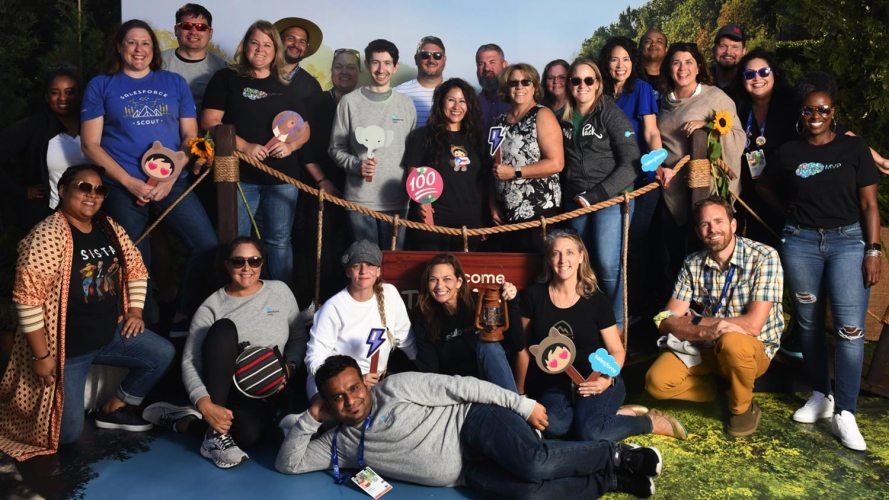Learn Cybersecurity Skills on Trailhead

Cybersecurity professionals are in high demand, and nontechnical roles are more prevalent than you might think.

Rachel Holz
Do you know what a cybersecurity expert looks like? Hollywood and popular culture have certainly painted a picture. However, the stereotypes fail to recognize the diversity of roles, both technical and nontechnical, within the cybersecurity career landscape. People with cybersecurity skills are in high demand and can work in roles across departments and industries. We’re here to help you learn cybersecurity skills on Trailhead, Salesforce’s free online learning platform.
Cybersecurity skills are in-demand
- Cybersecurity needs have permeated all roles in business, alongside the technology it seeks to secure. The rise of AI has only made the need for cybersecurity more pressing.
- The U.S. Bureau of Labor Statistics expects demand for cybersecurity professionals to increase by 35% by 2031.
- There are roughly 4 million cybersecurity professionals needed globally, according to a 2023 ISC2 Cybersecurity Workforce Study.
- Job prospects in cybersecurity are strong and there’s an average salary of $106,810 per year.
What is cybersecurity?
The primary goal of cybersecurity is to manage risk to an organization by protecting networks, systems, and data from security threats and vulnerabilities, as well as to identify, analyze, and respond to security breaches that could compromise an organization’s mission and goals.
One of the most significant risks to information security is often considered to be human beings. Some put the percentage of human error, simply an unintended action or decision, as the cause of 95% of cybersecurity incidents. This is why making sure your fellow employees are aware of risk and best practices is so important. But in reality, it’s not really employees that are to blame.
Learn cybersecurity skills on Trailhead
Promoting basic security protocols across an organization and making sure all employees are aware of how to avoid critical errors is core to cybersecurity. This work calls for the ability to communicate, lead projects, and develop plans and policies.
Leadership
Fostering a company’s security culture is an important cybersecurity step. Creating the right environment with security and awareness training and operations can influence the cyber hygiene of your employees. From rolling out password managers, to automated software patching, to targeted training and engagement efforts, there’s a lot a company can do to mitigate employee risk.
Learn these leadership skills
Security Awareness and Training: Learn what it means to build security awareness into an organization.
Security Culture: Explore the importance of a strong security culture for your organization.
Understanding AI
It’s important to stay current with AI trends and understand how AI might mitigate risk but at the same time, expand the threat landscape for your company and employees. This includes knowledge of the regulatory and ethical aspects of AI and how AI impacts policies, business strategy, data governance, and privacy. You can learn more about the relationship between cybersecurity and AI to understand its many implications.
Learn about AI threats and defences
Artificial Intelligence and Cybersecurity: Learn to identify AI risks and defense strategies for everyday applications.
Attention to detail
Conducting thorough incident response, developing policies and ensuring compliance, performing accurate vulnerability assessments, monitoring networks effectively, detecting phishing attempts, maintaining meticulous documentation, analyzing trends, and reporting. The list goes on of all the tasks that require a careful eye and detailed execution. Small oversights in these processes can have significant implications.
Learn these operations skills
Get Started with Incident Response: Learn how incident response improves an organization’s cybersecurity and how to incorporate incident response into your security program.
Learn Compliance and Regulatory Fundamentals: Discover the key players, rules, and challenges of compliance and regulation.
Get Started with Vulnerability Assessment: Learn how vulnerability assessment increases an organization’s cybersecurity strength and how to incorporate vulnerability assessment into your security program.
Communication
To influence and gain buy-in for decisions and execution strategies, you need effective stakeholder engagement, clear and engaging documentation, comprehensive training, and internal messaging that tells a compelling story. Explaining complex security concepts to nonexperts is a common requirement of security professionals, and it requires clear, effective communication, both oral and written, at the executive level and across the organizational chart.
Learn top-notch communication skills
Strategies for Communicating with Executives: Learn best practices for speaking to and emailing executives.
Collaboration
Maintaining security is a collective effort. You need to be able to collaborate across multiple teams and functions within an organization. You must be able to share best practices and coordinate effective crisis management plans. You’ll also want to use relationship building for industry collaboration with fellow cybersecurity professionals.
Learn about collaboration’s role in cybersecurity
Cybersecurity Threat Prevention and Response: Learn how to prevent, respond to, and recover from cyber attacks with cross-functional team team collaboration.
Problem-solving
This skill is at the heart of cybersecurity, with professionals regularly identifying vulnerabilities, investigating breaches, and devising fixes. You need to know how to assess risks, methodically analyze intelligence, and adapt to ever-evolving cybersecurity threats.
Learn these proven problem-solving techniques
Use the Center for Internet Security’s Risk Assessment Method: Manage cybersecurity risk with the Center for Internet Security’s Risk Assessment Method.
Threat Intelligence: Learn how threat intelligence prevents attacks on an organization.
The Emerging Future of Cybersecurity: Explore ways to mitigate risk and better prepare for the digital future.
Project management
You need to have a handle on effective technical project planning and organization, resource management, and decision-making and prioritization methods. Project management principles are important for various roles across the cybersecurity career spectrum from technical to nontechnical. It’s common for teams to take on several projects at a time. When various contributors are kept aligned on tasks and deadlines, it helps teams accomplish their goals.
Learn project management and prioritization skills
Technical Project Management: Learn how technical project management intersects with security in your organization.
Alignment as a Strategic Craft: Learn strategy design best practices, which emphasizing alignment, values, relationships, and accountability.
Empathy and emotional intelligence
Understanding the perspectives and concerns of users and adversaries is crucial. It guides the design of security measures and enables effective threat assessment. Empathy and emotional intelligence allow you to transform the way you communicate, apply a user-centric approach, control your reactions during a crisis, and even make more ethical decisions.
Learn these emotional intelligences skills
Empathetic Leadership: Learn strategies to help you lead with empathy.
Emotional Intelligence: Use self-awareness and self-management to strengthen relationships and be more productive.
Understand the diverse roles of cybersecurity professionals
Cybersecurity is a field that balances two distinct but equally critical components: technical and nontechnical roles. Any technical implementation would be chaotic and largely ineffective without the rules, policies, and protocols laid out by those in nontechnical roles. Similarly, the decisions and written policies that cyber leadership establishes would be ineffective without the technical skills to implement them.
Technical roles are more well-known for fighting cyber threats, identifying vulnerabilities, implementing security measures, and continuously monitoring and updating defenses. These roles most likely require hands-on skills directly related to hardware and software. These roles often require proficiency in mathematical computations, coding, programming, understanding networking protocols, cloud computing, operating systems, and cybersecurity tools.
Nontechnical roles focus more on business-related initiatives like company policies, incident response procedures, and security training for employees. Individuals in these roles think about risk management, cybersecurity awareness, security auditing, strategic planning, and policy development. Common departments for nontechnical cyber roles are human resources, legal and regulatory affairs, and finance, contributing to strategy, policy, and organizational risk management.
Explore cybersecurity career paths
- Security awareness specialist: Develop learning and awareness programs to create a culture of cybersecurity within an organization.
- Technical project manager: Develop and manage IT project plans, including tasks, milestones, status, and allocation of resources.
- Threat intelligence analyst: Identify threats through intelligence analysis and support incident response and forensics efforts.
- Cybersecurity risk manager: Protect digital business assets by managing risks, including identifying, assessing, and mitigating the risks to systems and networks.
- Cybersecurity compliance analyst: Protect businesses and consumers from breaches by helping them comply with security laws, regulations, standards, and policies.
- Cybersecurity leader: Manage teams and oversee business and technology activities in security-related matters.
Salesforce has partnered with the World Economic Forum, Fortinet, and the Global Cyber Alliance to create resources to support the next generation of cybersecurity professionals. And we’re hoping you’re one of them. The Cybersecurity Career Path is a partnership between these powerhouse organizations, who are all dedicated to tackling the skills gap in cybersecurity and creating career opportunities.
Get started on the path to a successful cybersecurity career
I’m a good example of someone who didn’t have cybersecurity experience coming into the field. But, my business skills include communication, relationship-building, project management, detail-orientation, and training. These skills made me a great fit for the security awareness and training role I applied for. As for the cybersecurity-related aspects, I learned those on the job. The rest, as they say, is history!
If you’re looking for a fulfilling, dynamic, and lucrative career where you’re learning all the time and using a diverse set of skills, look no further than cybersecurity. Here are some recommended steps to get started on your journey to learn cybersecurity skills and begin your career path.
- Get your foundation: Learn about cybersecurity concepts and best practices. Use resources like Trailhead, the World Economic Forum, Fortinet, and the Global Cyber Alliance.
- Develop your practical skills: Gain hands-on experience through internships, projects, or a bug bounty program.
- Network: If you don’t know anyone in the cybersecurity field, don’t worry. Salesforce’s Trailblazer Community has an entire group of people called Cybersecurity Trailblazers who can help along the way.
Read more about careers on the blog
Salesforce skills open doors to careers around the world. Discover your perfect career path.






























